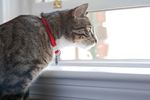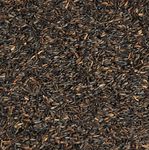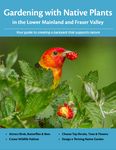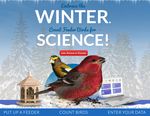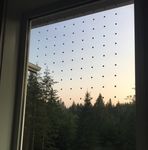SUPPORTING WILD BIRDS THROUGH WINTER - HOW TO HELP AND HAVE FUN TOO!
←
→
Page content transcription
If your browser does not render page correctly, please read the page content below
VANCOUVER AVIAN RESEARCH CENTRE
SUPPORTING WILD
BIRDS THROUGH WINTER
HOW TO HELP AND HAVE FUN TOO!
HOW DO THEY DO IT?!
Every year, people in North America spend over $122 BILLION
Not all birds will fly south for the
on bird related activities.
winter months. Those that stay face
1 in 4 American adults are bird watchers.
the seemingly impossible to survive!
60 million people watch birds, making it the biggest spectator
sport in North America! More people watch birds than hockey
There are three main obstacles that
and football combined!
residential wintering populations In the United Kingdom, more than half of all adults feed garden
face - staying warm, finding food birds!
and finding water. Many species
have special adaptations or Feeding birds can help them overcome natural food shortages,
behaviours that they employ. Some survive periods of severe winter weather and help them to become
species make their homes closer to better breeders in the spring.
the ground in the winter to avoid
harsh wind chills. Others may If you do decide to feed your garden birds, it is important to
congregate in large groups to stay feed them responsibly and safely. It is also very important that
warm and to stay informed of new you continue to feed them throughout the winter as they will
food sources! learn to depend on the supply for survival.
Regardless of how each species Extra feeding alone won't provide all of the natural proteins and
vitamins that a bird needs. By creating bird friendly gardens at
survives, it is always an incredible
home or school you will be giving sources of natural foods as well.
and inspiring feat.
If you offer both natural food and feeder food, your garden will be
visited year-round by a host of different birds.VARC | SUPPORTING WILD BIRDS THROUGH WINTER
Unlike humans, birds need high levels of saturated fat. They
need the high energy content to keep warm in cold weather,
since their body reserves are quickly used up. Birds have high
body temperatures and rapid metabolisms. A Sparrows heart
beat is 460 beats per minute!
WHAT TO FEED BLACK SUNFLOWER NYJER
BLACK SUNFLOWER SEEDS: Excellent year-round food. The SEEDS SEEDS
hearts (husked kernels) are a great no-mess food.
NYJER SEEDS: Small, black seeds with high oil content. A
favourite of American Goldfinches & Pine Siskin's.
PEANUTS: Rich in fat, but can be high in a natural toxin which
can kill birds. Buy from a reputable dealer such as Wild Birds
Unlimited. Salted or dry roasted peanuts should be avoided.
FAT BALLS & SUET: Excellent winter food. Be careful of mesh PLAIN FAT BALLS
bags as they can trap or injure wild birds. PEANUTS & SUET
LIVE FOOD: Mealworms! It is important that they are fresh.
Remove dead or discoloured ones because they can cause
salmonella poisoning.
COOKED RICE (WITHOUT SALT) IS OK: Uncooked rice is less
attractive to birds.
BREAKFAST CEREAL (IN SMALL QAUNTITIES) IS OK: Best
MEALWORMS COOKED RICE
offered dry because it quickly turns to mush when it gets wet.
WHAT NOT TO FEED!!
NO COOKED PORRIDGE OR OATS: They harden around a bird’s beak.
NO MIXTURES WITH SPLIT PEAS, BEANS, DRIED RICE OR LENTILS: Only OK for large birds like pigeons and
doves, keeping smaller species away.
NO MIXTURES WITH PINK OR GREEN LUMPS: They are dog biscuit pieces and can only be eaten when soaked.
NO COOKING FAT: When meat juices blend, smearing can happen which is not good for bird feathers. It is also
a breeding ground for bacteria. Lard and beef suet on their own are fine. They re-solidify and are not as
attractive to bacteria.
NO PET FOOD: It attract cats.
NO MILK: Their guts are not designed to digest milk. Mild, grated cheese is OK.
NO POWDERED OR DEHYDRATED COCONUT: It can swell inside a birds stomach. Give fresh coconut only in
the shell.
NO BREAD: It provides no goodness or nutrients and swells in their stomach.
IMPORTANT TIPS DON'T FORGET ABOUT WATER!
Always remove stale or moldy food. It is a The NUMBER 1 BEST WAY to
breeding ground for salmonella bacteria, attract birds is to put out
which can cause food poisoning. copious amounts of clean,
Large quantities of food scattered on the fresh water.
ground may attract rats and mice. Clean and
wash your bird table and hanging feeders Most small birds need water
regularly (ideally, use a 5% disinfectant twice a day to drink and to
solution) and move feeding stations to a new bathe. It is essential to
area close by to prevent food gathering in keeping feathers in good
one spot. condition.VARC | SUPPORTING WILD BIRDS THROUGH WINTER
YOU CAN SAVE BIRDS!
There are some very important and very simple things you can do to help save birds all year round!
Besides providing food and water, our top 3 list is a great place to start.
PLANT NATIVE SPECIES: Planting native species means that we are planting trees and flowers that are
naturally from the area. This means that birds and other wild animals have access to the nutrition that
they need and that is proper for their diet. Planting species that are not from our area can make wildlife
sick and can disrupt the environment in other ways too. Visit the Fraser Valley Conservancy for more
information on what species are native to the Vancouver area and why they are beneficial. Visit the
Habitat Network for great advice on planning and designing your garden so it is bird and nature friendly.
KEEP PETS INDOORS & ON LEASH: Cats are very good hunters! Unfortunately, using a bell and a collar
does not stop these whiskered experts. The best way to protect wild birds and your pet from outdoor
injury and disease is to keep them indoors. For dogs, straying off designated paths in parks can also be
dangerous as many animals, including some birds, make their nests and homes on the ground. They are
often hard to see until it is too late. Keeping your dog on leash is a great way to protect ground dwelling
birds and wildlife
PREVENT WINDOW STRIKES: Bird are not able to see through glass and in fact, often see a reflection of
their habitat (trees or sky) just like looking into a mirror. One way to prevent window strikes is to create
beautiful Mobiles and Chimes to hang in front of windows. The movement and noise will make birds
nervous and they will do their best to avoid the area.
The best way to prevent window strikes however, is to install specialized window markers on the outside
of the glass. Canadian companies like Feather Friendly are leaders in this life saving field and offer
applications for residential homes.
THERE ARE MANY WAYS TO HELP BIRDS
Don't stop here! The list is nearly endless on how you can make small changes that have a big
impact on , not only birds, but our environment as a whole! Visit our website for even more ideas.
www.birdvancouver.com/what-you-can-do/
You can also challenge yourself to search online and initiate one new action to help our planet
each month!VARC | SUPPORTING WILD BIRDS THROUGH WINTER
CITIZEN SCIENCE
Check out these resources on how to become a citizen scientist for birds!
PROJECT FEEDER WATCH: Feeders are a great way to learn about
wildlife and get close to birds! Feeding birds is supported by Bird
Studies Canada and the Cornell Lab of Ornithology. Project Feeder
Watch is a citizen-science project where you count birds at your
feeder between November and April.
VISIT THE WEBSITE HERE
EBIRD FROM THE CORNELL LAB OF ORNITHOLOGY: Transforms
your bird sightings into science and conservation. Plan trips, find
birds, track your lists, explore range maps and bird migration.
VISIT THE WEBSITE HERE
BIRDS CANADA: Start your own life list and get to know what birds
are local to your area. Birds Canada's interactive map will show
you what birds you can expect to see in your area at any time of
the year! It is a great way to get to know and identify birds for
your local life list.
VISIT THE WEBSITE HERE
GLOBAL BIRD COLLISION MAPPER: A place for reporting and
viewing the locations of bird collisions with buildings across the
globe. Help this new scientific program gather valuable data today.
VISIT THE WEBSITE HERE
VARC: Another great way to get involved with citizen science is to
volunteer! From bird banding opportunities, public outreach and
education to general maintenance work, VARC has plenty of
opportunity for a volunteer just like you!
VISIT THE WEBSITE HERE
TO FIND OUT MORE PLEASE VISIT US!
WWW.BIRDVANCOUVER.COMYou can also read




